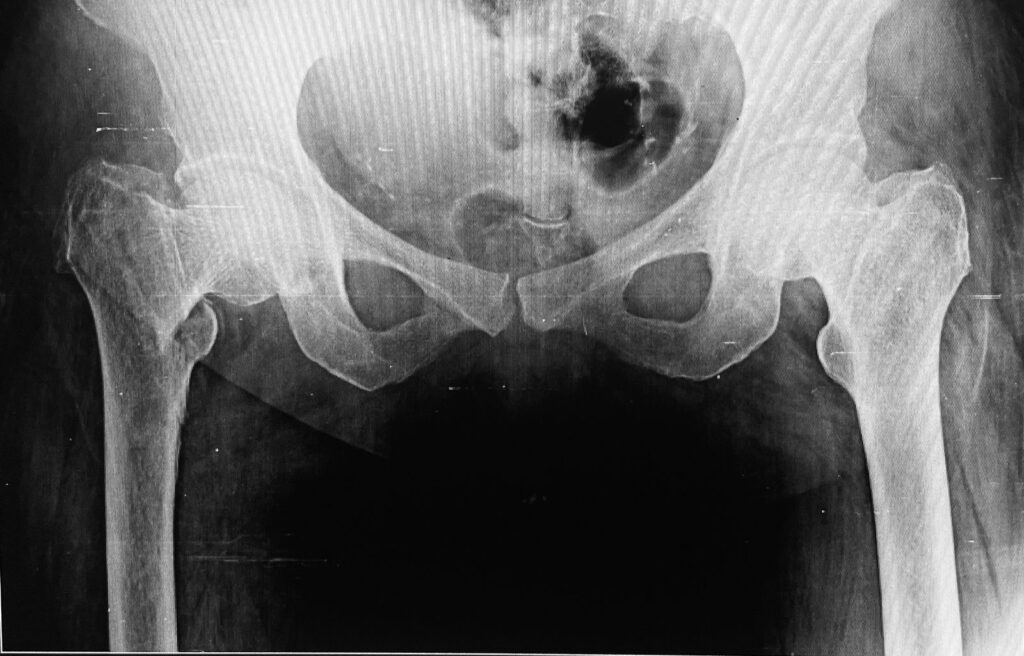Hip fractures in elderly patients are among the most frail and sickest situations that most doctors come across. These patients have to overcome complex medical conditions, including comorbidities, along with the physical challenges of the hip fracture, followed by subsequent surgery. Some published guidelines emphasises the need for multidisciplinary care and the importance of a good environment.
This case study examines an elderly female who recently suffered hip fracture and was presented to doctor Swapnil Gadge at the Gadge Hospital. Being a well-known orthopaedic surgeon, doctor Swapnil employed innovative surgical methods in joint replacement surgery by the successful implementation of a long stem hemiarthroplasty.
Patient Profile:
The patient, whose identity remains confidential, is an elderly female with a history of a fall at home resulting in a right hip joint injury. The injury was further marked by the subsequent weight-bearing femoral fracture, significantly leading to increased complexities associated with surgical interventions. The situation escalated with the patient experiencing increased pain, ultimately leading to the inability to walk. The primary concern was the potential exacerbation of respiratory issues post-surgery. Examination revealed high surgical risk and comorbidities.

Preoperative Assessment and Decision Making:
With his extensive experience in orthopaedics, Dr. Swapnil has created an innovative solution for the unexpected complications related to hip injury. The expert physician conducted a detailed assessment of the patient’s medical history, while also employing a combined management approach identifying the complex needs of the patient, including cognitive impairment, nutrition, etc. His expertise also focused on identifying the high risk associated with traditional surgical interventions due to comorbidities.
Decision for Joint Replacement:
Keeping in mind the condition complexities, while also considering other factors of the fracture, Dr. Swapnil Gadge decided for a surgical procedure called long stem hemiarthroplasty. The procedure calls for a partial hip replacement to treat hip fractures and may also be employed in rare cases to treat hips damaged by arthritis. After analysing the complete condition that the patient is suffering from, doctor Swapnil, best doctor for hip fracture management, suggested joint replacement to ensure stability and faster postoperative recovery. Hemiarthroplasty is often a necessary treatment to restore hip function.
Surgical Procedure:
Long Stem Hemiarthroplasty: The surgical procedure for joint replacement was wholly highlighted by the expertise of Dr. Swapnil Gadge. The doctor conducted the surgery smoothly to replace the fractured part of the femur with an appropriately sized long stem hemiarthroplasty implant.

Postoperative Care: Post Surgery patient was put on Antibiotics and painkillers. Apart from these medications, the doctor also advised the patient to begin with physical therapy soon after the surgery as it will help regain life back to normal.
Early Mobilisation: The patient mobilised the day after surgery, which is a good sign of a proactive rehabilitation approach. To encourage joint function, the doctor advised to begin walking initially with a walker, allowing the patient to bear some weight.
Gradual Progression: At the Gadge Hospital, a plan was designed for a progressive increase in weight bearing, while ensuring the patient’s comfort and safety. The plan included the walking sessions under supervision to improve muscle strength and joint stabilisation.
Exceptional Work by Dr. Swapnil Gadge:
Individualised Care: Dr. Gadge’s attention to detail reflected in his personalised care plan that was tailored to each patient’s individual needs. The doctor’s concern for patient safety was evident in his consideration of comorbidities, and the high surgical risks.
Expertise in Joint Replacement: The successful implementation of Dr. Swapnil Gadge’s long stem hemiarthroplasty demonstrates his proficiency in joint replacement surgeries. With his precision in surgical techniques, the potential risks of complications were minimised.
Proactive Rehabilitation Approach: Dr. Gadge took a proactive approach in postoperative care with his early mobilization and progressive rehab plan. With his timely intervention to the patient’s rapid recovery, the patient got back to her normal life quickly.
Patient’s Outcome:
Successful Recovery: The patient showed remarkable improvement throughout the postoperative period, with noticeable gains in joint mobility and functionality. This progress is a testament to the surgical success achieved through the expertise of Dr. Gadge at one of the best hip fracture hospitals in Nagpur.
Discharge Planning: The patient on his discharge upon successful surgery, received a plan from the hospital that includes a detailed rehabilitation program and follow-up treatment. This comes after the doctor’s advice to exercise at home to maintain recovery and prevent complications.
Conclusion:
Overall Impact: This surgical case at the Gadge Hospital showed the successful treatment of a hip fracture complex in an elderly patient. The exceptional work by Dr. Swapnil Gadge, from preoperative decisions to postoperative care played a crucial role in driving the successful outcomes.
Acknowledgment of Expertise: The success behind this surgical procedure was due to Dr. Gadge’s expertise in joint replacements and his commitment to patient-centred care. This case study highlights the hospital’s commitment to providing outstanding orthopaedic services in Nagpur.
Finally, the hip fracture management in an elderly female at the Gadge Hospital managed by Dr. Swapnil Gadge is a testament to individualised care, surgical experience, and a proactive rehab approach for achieving positive outcomes.
